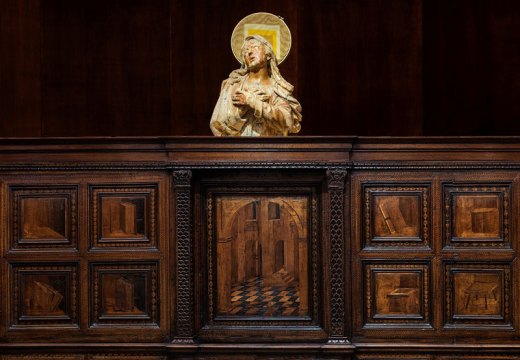‘Turin is the first city in Italy and only the second in the world to offer historical and contemporary art fairs simultaneously to the public.’ That, says Ginevra Pucci, is one reason that Italian collectors have been so quick to take note of Flashback (5–8 November), the boutique historical fair that, for the third year running, coincides with the contemporary art juggernaut that is Artissima (6–8 November). Pucci and co-director Stefania Poddighe have swiftly built up a fair with the laudable aim of introducing a new, and perhaps younger audience to traditional collecting fields. Its motto? ‘All art is contemporary.’

Spazio anche più che tempo (Space even more than time) (1951), Carol Rama. Galleria del Ponte
Like Frieze Masters, a fair whose aspirations it mirrors, Flashback encompasses a wide range of fields, pressing the modern against high-quality arte antica and presenting everything from Asian art to fine art photography. The fair’s watchwords are quality and inclusivity, the latter in terms of both exhibits and visitors. There is a genuine desire here to kickstart connoisseurial interest among greenhorn collectors, who are likely to be better acquainted with the installation art on show nearby at the Oval than they are with limewood sculpture or devotional panel paintings.
Thirty-five galleries will be exhibiting at the Pala Alpitour venue this month, and while the majority are Italian, these include major international players such as Moretti Fine Art and Robilant + Voena. This year the fair has a strong showing of 20th-century Italian works – a focus that may seem de rigeur at art fairs these days, but could hardly be more apt in Turin. This city was integral to the development of both modern and post-war Italian art: it was here that F.T. Marinetti first presented the Futurist Manifesto in 1910; and here that the curator Germano Celant staged the first arte povera exhibitions in the late 1960s.

Niente da vedere niente da nascondere (1976), Alighiero Boetti. project room
Of particular interest in this field will be works by the late Carol Rama, the self-taught Torinese artist whose psychologically intense paintings from the 1970s were largely created from bicycle tyres. Galleria del Ponte brings Spazio anche più che tempo (Space even more than time; 1971), in which rubber adheres to canvas and hessian like a patchwork of industrial sticking plasters. Continuing the focus on the Italian art of the period is ‘Niente da vedere niente da nascondere’ (Nothing to See Nothing to Hide), one of this year’s special projects, which takes its title from Alighiero Boetti’s text embroidery of 1969, first exhibited at Galleria Sperone in the city. ‘Flashback keeps strengthening its cultural offer,’ says Pucci, ‘because collecting can’t exist without knowledge.’

Spring landscape with pheasants, screen with six doors (Kano School Half of the Edo period; 1615-1867)
The co-director has a clear sense of how contemporary art collectors are branching out into more connoisseurial fields: ‘The first step for some of them is Japanese art […] which is often perceived as more similar to contemporary work, followed by late medieval and early 15th-century art, from gold-ground paintings to wood sculpture – but there are also collectors who have fallen for baroque painting.’ Among the Japanese highlights here is an exceptional screen of the Kanō school, dating to the Edo period (1615–1867), showing wildfowl on the banks of a pool next to blossoming trees (Giuseppe Piva Arte Giapponese). Italian primitive paintings at the fair include a panel by Bicci di Lorenzo, depicting a miracle of St Giovanni Gualberto: outraged by the decorative richness of the abbey of San Pietro Moscheta, the founder of the Vallombrosan order commanded a river to ravage the building; it is shown here as a rather haughty tower, being swept away on the current. The painting, originally part of an altarpiece in the church of Santa Trinita in Florence, is brought to the fair by Salamon & C Art Gallery.

Miracle of St Giovanni Gualberto, Bicci di Lorenzo (c. 1368–1452). Salamon & C Art Gallery
Over at Artissima, more than 200 galleries will be exhibiting, more than two thirds of which are based outside Italy. But beyond the business, don’t miss ‘In Mostra’, an exhibition drawn from Piedmont’s institutions and private collections to showcase the strength of contemporary art collecting in the region. Works by some 30 artists will be shown, including pieces from the Fondazione Merz, the Fondazione Pistoletto and the Castello di Rivoli collections.
Flashback runs from 5–8 November.
Unlimited access from just $16 every 3 months
Subscribe to get unlimited and exclusive access to the top art stories, interviews and exhibition reviews.














![Masterpiece [Re]discovery 2022. Photo: Ben Fisher Photography, courtesy of Masterpiece London](http://www.apollo-magazine.com/wp-content/uploads/2022/07/MPL2022_4263.jpg)
Has the Fitzwilliam lost the hang of things?